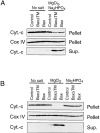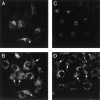Bax-induced cytochrome C release from mitochondria is independent of the permeability transition pore but highly dependent on Mg2+ ions
- PMID: 9763433
- PMCID: PMC2132823
- DOI: 10.1083/jcb.143.1.217
Bax-induced cytochrome C release from mitochondria is independent of the permeability transition pore but highly dependent on Mg2+ ions
Abstract
Bcl-2 family members either promote or repress programmed cell death. Bax, a death-promoting member, is a pore-forming, mitochondria-associated protein whose mechanism of action is still unknown. During apoptosis, cytochrome C is released from the mitochondria into the cytosol where it binds to APAF-1, a mammalian homologue of Ced-4, and participates in the activation of caspases. The release of cytochrome C has been postulated to be a consequence of the opening of the mitochondrial permeability transition pore (PTP). We now report that Bax is sufficient to trigger the release of cytochrome C from isolated mitochondria. This pathway is distinct from the previously described calcium-inducible, cyclosporin A-sensitive PTP. Rather, the cytochrome C release induced by Bax is facilitated by Mg2+ and cannot be blocked by PTP inhibitors. These results strongly suggest the existence of two distinct mechanisms leading to cytochrome C release: one stimulated by calcium and inhibited by cyclosporin A, the other Bax dependent, Mg2+ sensitive but cyclosporin insensitive.
Figures






References
-
- Antonson B, Conti F, Ciavatta AM, Montesuit S, Lewis S, Martinou I, Bernasconi L, Bernard A, Mermod J-J, Mazzei G, Maundrell K, Gambale F, Sadoul R, Martinou J-C. Inhibition of Bax channel forming activity by Bcl-2. Science. 1997;277:370–372. - PubMed
-
- Bernardi P, Petronilli V. The permeability transition pore as a mitochondrial calcium release channel; a critical appraisal. J Bioenerg Biomembr. 1996;28:129–136. - PubMed
-
- Beutner G, Rueck A, Riede B, Welte W, Brdiczka D. Complexes between kinases, mitochondrial porin, and adenylate tranlocator in rat brain resemble the permeability transition pore. FEBS (Fed Eur Biochem Soc) Lett. 1996;396:189–195. - PubMed
-
- Boyer PD. The ATP synthase—a splendid molecular machine. Annu Rev Biochem. 1997;66:717–749. - PubMed
MeSH terms
Substances
LinkOut - more resources
Full Text Sources
Other Literature Sources
Research Materials

